July 1903: Edward VII, the Gordon Bennett Cup and the Emmet centennial
Published in 20th-century / Contemporary History, Features, Issue 3 (May/June 2011), Volume 19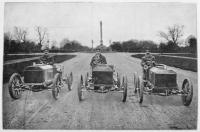
The British team, holders of the Gordon Bennett Cup, Stocks, Jarrot and Edge, pictured in Dublin’s Phoenix Park. From the start, the race had its critics. Besides the perennial cranks and Luddites, the ancestors of today’s Greens saw in the smoke, the smell and the hurtling vehicles threats to the rural placidity of Irish agricultural life. (Brendan Lynch)
After five years of ’98 commemorations, actively militant opposition to the Boer War and the imminent passage of what was to become known as the Wyndham Land Act, unionists faced the prospect of two more potentially inflammatory commemorations: the centennial of Robert Emmet’s rebellion (23 July) and of his execution (20 September). In the eyes of the radical Irish nationalist press, therefore, the staging of the Gordon Bennett Cup race (2–14 July) and the first royal visit of King Edward VII (19–27 July)—announced within days of one another in late March—were calculated to upstage the centennial and to bolster the morale of increasingly apprehensive unionists.
Nationalist opposition
The enabling legislation to stage the Gordon Bennett Cup race in Ireland, long discussed in
motoring circles since Selwyn Edge’s win in July 1902, received royal assent on 27 March 1903. Four days later came the announcement that King Edward VII would make his first royal visit to Ireland. This provoked an immediate and predictable controversy. Recalling the protests over the visit of Queen Victoria only two years previously and the refusal of the Irish Party to participate in the ceremonies that marked the coronation of her son (1902), Irish public opinion became stridently divided, especially in Dublin. In ‘advanced nationalist’ circles, just as on those recent occasions the queen’s visit had been seen as a ploy to recruit soldiers for the Boer War, and attendance at the coronation asimplying loyalty to an illegitimate sovereign power, so was the political allegiance of Dublin Corporation to be again put to an uncomfortable public test. The debate on the particular issue of whether or not to accord the king a formal address of welcome to the city became a hot topic around dinner tables, in bars and at every public meeting between March and July.
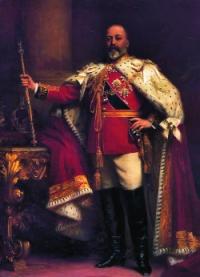
Edward VII at his coronation in 1902. The Irish Party refused to participate in the ceremonies.
While the visit was public and official, proponents of a statement of respect (led by Lord Lieutenant Dudley) resorted to appeals for ‘common courtesy’ and to ‘traditions of Irish hospitality’. Moderate opinion held that it was in Ireland’s interest to cultivate the benignity of the royal couple: by declaring his intention to visit, Edward was signalling his approval of the land act on its way through parliament (and he was, moreover, rumoured to favour personally even Home Rule). Radical (or, as The Times of London termed them, ‘professional’) nationalists took the view that all of these arrangements—ceremonial, sporting and legislative—were constituents of a coordinated programme in the imperial cajoling of the public will. Their political purpose was to renew in the minds and hearts of the Irish people pride in and gratitude for their membership of the world’s greatest empire and loyalty to its genial monarch.From the start, the race had its critics. Besides the perennial cranks and Luddites, the ancestors of today’s Greens saw in the smoke, the smell and the hurtling vehicles threats to the rural placidity of Irish agricultural life. More concerted objections came from the radical nationalist press, most notably the Irish People (William O’Brien), The Leader (D.P. Moran), An Claidheamh Soluis (Patrick Pearse) and, most persistently, The United Irishman (Arthur Griffith). On 13 June Griffith wrote:
‘The motor race is one of the symbols of that “union of hearts”, which, according to the newspapers, we are now witnessing in Ireland; perhaps the smell which the motor-car leaves behind is symbolic, too . . . At the bottom of all this motor racing, however, there is not even any kind of sporting feeling, such as it is. It is simply a commercial venture between rival manufacturers, and one of the inspired statements issued to the Irish press recommends the thing on the ground that if an English-made car wins, it will greatly stimulate the motor industry in “this country”. The geography of the Automobile Club is like Lord Charles Beresford’s history. But in this sentence we have an indication of what is at the basis of the whole business.’
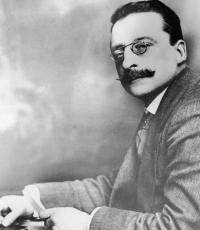
Arthur Griffith—‘. . . perhaps the smell which the motor-car leaves behind is symbolic, too . . .’. (George Morrison)
In parallel with this brief controversy, the prospect of King Edward’s visit—and the degree of recognition it was to receive officially—was the subject of a long-running and acrimonious debate at meetings of Dublin Corporation. One such meeting—which saw Edward Martyn, Maud Gonne and Arthur Griffith make vociferous objections to the motion to accord the king a cordial welcome—came close to blows and became known as ‘the battle of the Rotunda’. The newspapers carried letters from prominent citizens supporting Griffith and Gonne, among them Yeats and George Moore. In language that applied equally to the euphoria promoted by sponsors of the car race, Yeats vigorously rebuked the hype surrounding royal visits:
‘. . . with their pageantry, their false rumours of concessions, their appeal to all that is superficial and trivial in society, [they] are part of the hypnotic illusion by which England seeks to take captive the imagination of this country, and appeal to what are chiefly money interests’.
George Moore protested the king’s visit by having his front door at Ely Place painted green, much to the annoyance of his unionist neighbours. To express his disdain for the bishops’ entertaining of the king at Maynooth, in a scornful letter to the Irish Times he declared himself a Protestant. Yeats asked whether he could expect to read that ‘Cardinal Logue had “something on” Sceptre and that Archbishop Walsh has “a little bit of all right” for the Chester Cup’.
Gryffygryffygryffs
In the pages of the United Irishman, Griffith pushed such sectarian carping further in two signal ways. He argued that hosting the race and the royal visit dishonoured Irish religious, cultural and political traditions and denigrated the memory of Emmet’s rebellion. He was at least half-correct. On the precise centennial of this last effort of the United Irishmen, 23 July, the king and his cavalcade were riding in state through the very same streets—Dame, Thomas and (yes) Emmet—which had seen the brief and ineffectual action led by the iconic patriot and martyr. Accompanying Edward and his queen, Alexandra, George Wyndham observed that the onlookers
‘. . . became merely delirious. They worked themselves into an ecstasy and all sang God Save the King. The queen kept pointing to this or that tatterdemalion saying “the poorer they are, Mr Wyndham, the louder they cheer”. There was ever and always the same intense emotion. It brought tears to the queen’s eyes, and a lump in my throat . . . here was a whole population in hysteria.’
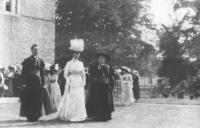
Queen Alexandra at St Patrick’s College, Maynooth. To express his disdain for the bishops’ entertaining of the royal couple, George Moore, in a scornful letter to the Irish Times, declared himself a Protestant. (MultiText)
In the event, the crowds greeting the monarch that day were dwarfed by the estimated 100,000 thronging the same streets on 20 September.
Whereas Moore and Yeats had their moments in print, Griffith’s single-mindedness turned the occasion into an opportunity for serious, long-term, non-violent action for Home Rule. He was already engaged in organising an Irish Industrial Exhibition to further his ‘buy Irish’ campaign in opposition to the International Exhibition sponsored by William Martin Murphy and the earl of Drogheda. He then formed the National Council, which morphed into Sinn Féin (January 1904). Within two years his new formation was offering a serious political challenge to the Irish Party, which he could represent as having allowed itself to be co-opted by colonial interests. His Resurrection of Hungary (serialised in the United Irishman during the first six months of 1904 and published as a whole in September)
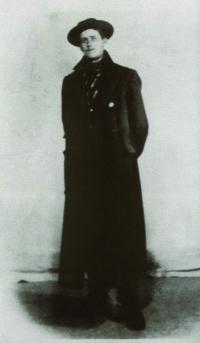
James Joyce, pictured here in Paris, December 1902—a sympathetic eyewitness to these events and a subscriber to Griffith’s The United Irishman. His three most politically aggressive stories—‘After the Race’, ‘Ivy Day in the Committee Room’ and ‘A Mother’—are arch responses to Griffith’s efforts protesting the car race and the king’s visit. (Beinecke Rare Book and Manuscript Library, Yale University)
argued for a devolutionary process modelled on the successful efforts of the Hungarians to establish a dual monarchy relatively free of the traditional hegemony of the Viennese Hapsburgs. In a stroke that craftily drew on the emotions stirred by the popular controversy the previous July over the Gordon Bennett Cup race and the king’s visit, Griffith argued that Ferenc Deák’s refusal to accord Emperor Franz Josef a royal welcome when visiting Buda Pesth, ostensibly for a race meeting, in 1865 was the first moral step towards the liberation of the Magyars from the thrall of Austrian hegemony.Griffith’s stamina in pursuing legitimate pacific protest had such relatively humble but parallel beginnings, eventually leading to the triumph of Sinn Féin in the 1918 general election. The tactics and politics pursued by the first Dáil were those outlined in The resurrection of Hungary, which had its origins in the opportunities of midsummer 1903. Griffith’s moral courage and political intelligence transformed casual incidents into axial events.
A sympathetic eyewitness to these events was Griffith’s most gifted subscriber to the United Irishman, James Joyce. His three most politically aggressive stories—‘After the Race’, ‘Ivy Day in the Committee Room’ and ‘A Mother’—are arch responses to Griffith’s efforts protesting the car race and the king’s visit, and his sponsorship of the Irish Industrial Exhibition. These political rituals (and the Emmet centennial rally registered in the ‘Cyclops’ episode of Ulysses) are the only significant historical events that became the occasions of Joyce’s fiction. They were made historical by the virtues that Griffith shared with that fierce defender of the national treasure and traditional enemy of imperial horsepower, the Gryphon, the ‘Gryffygryffygryffs’ of Finnegans Wake. HI
Cóilín Owens is the author of James Joyce’s Painful Case (2008) and How Joyce writes ‘After the Race’ (forthcoming).
Further reading:
A. Griffith, The resurrection of Hungary (Dublin, 1904 [2003]).
B. Lynch, Triumph of the red devil: the Irish Gordon Bennett Cup race (Dublin, 2002).
P. Maume, The long gestation: Irish nationalist life, 1891–1918 (New York, 1999).
S. Ó Lúing, Art Ó Gríofa (Baile Átha Cliath, 1953).
















